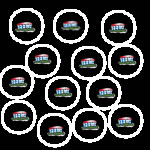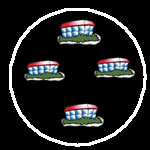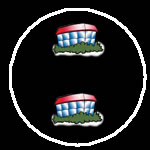In this unit we will mainly focus on the difference between a monopoly and and a perfect competitor.
There are several different types of imperfect competition - you will mainly need to be aware of the Monopoly situation.
| Market Situation | Perfect Competition | Monopolistic Competition | Oligopoly | Duopoly | Monopoly |
 |
 |
 |
 |
 |
|
Features |
Many sellers of a homogenous product. |
Many sellers of a differentiated product. |
A few sellers of a differentiated product, which are close substitutes. |
A few sellers of a differentiated product, which are close substitutes. |
One seller. No substitutes. |
Entry |
No Barriers to entry |
Weak barriers to entry |
Strong barriers to entry |
Strong barriers to entry |
Strong barriers to entry |
Control |
No control over price. |
Slight control over price. |
Strong to slight control over price. |
Strong control over price. |
Strong control over price or quantity. |
Type of product. |
Homogenous |
Differentiated |
Differentiated |
Differentiated |
No close substitutes. |
Advertising |
No need to advertise. |
Point of sale or local advertising only. |
Aggressive advertising. |
May be aggressive advertising. |
No advertising. |
Characteristics of a Perfect Comptitor.
There are no barriers to entry into the market nor barriers to leaving the market. Anyone can enter or exit the market as they want.
All sellers are selling a homogenous product, a product which is the same as everyone else’s.
There are a very large number of buyers, none of whom can influence the market on their own.
Sellers in the market are price takers not price makers. There are a large number of sellers in the market, none of whom is able to influence price – there is only one price, the market price.
Prices are set by demand and supply in a market free from any external influences such as Government regulation. There will be only one price in the market, the market price.
There is Perfect Knowledge in the market place. If one seller raises their price, everyone will know about it, and avoid them. There is no need for any seller to advertise.
Sellers can sell all they want at the marketprice. If they raise their price, they will sell nothing, and no sensible person would lower their price if they can already clear all their output at a higher price.
Characteristics of a Monopoly.
Only one seller.
Strong Barriers to entry. There may be extremely high start up costs / capital costs making it very difficult for any other firm to enter the market, or patents stopping other firms from making the product.
A super normal profit can be made, in the long run.
Strong control over PRICE or QUANTITY but not both. If a firm wishes to set the price it can – but then it has to accept whatever the quantity the market requires at that price.
The sole seller offers a product for which there are no close substitutes.
No advertising.
Imperfect knowledge.
Monopsony. This occurs where there is a single buyer of a product. In New Zealand Fonterra tends to be a monopsony, buying 96% of milk production when it was first formed.